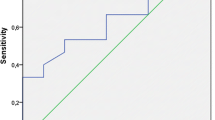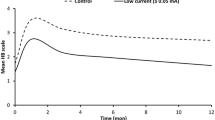Abstract
Background
Second surgery of recurrent vestibular schwannoma (VS) after previous surgery, stereotactic radiosurgery (SR) or fractionated radiotherapy (FR) carries an increased risk for deterioration of facial nerve function, e.g., due to adhesions, underlining the need for intraoperative monitoring. Facial “A-train” EMG activity (“traintime”) correlates with the degree of postoperative facial palsy. Studies investigating A-trains in VS patients with previous surgery, SR or FR are missing. We therefore investigated the value of A-train monitoring in patients undergoing second surgery for VS.
Method
Intraoperative EMG data from patients who underwent second surgery for VS after previous surgery, SR and/or FR at our institution between 2006 and 2012 were retrospectively analyzed. Ten patients were selected (5 male): Seven had previous SR/RT and MS, three previous surgery only. Traintime values and distribution was compared to published thresholds and to 77 patients who underwent first surgery for VS during the same time period.
Results
A-trains were recorded early after opening of the dura, before facial nerve preparation. Mean traintime was 46.9 s (18.51 s – 80.82 s) in patients with previous SR/RT. In patients with previous MS only, traintime was 0.06 s, 0.99 s and 22.46 s. Compared to the literature, traintime was higher than expected in six patients (four with previous SR/RT, two without), respectively seven compared to the 77 patients with first surgery (5 SR/RT). Seven patients with previous SR/RT and none with previous surgery showed diffuse A-train distributions without significant percentages in single channels, compared to 60 of 77 patients with first surgery (p < 0.02).
Conclusions
Especially SR/RT, but also previous surgery seems to induce changes in the facial nerve leading to hyperexcitability and exceedingly high traintime values. Based on these findings, A-train monitoring in this specific patient group should be interpreted with caution.



Similar content being viewed by others
References
Arthurs BJ, Fairbanks RK, Demakas JJ, Lamoreaux WT, Giddings NA, Mackay AR, Cooke BS, Elaimy AL, Lee CM (2011) A review of treatment modalities for vestibular schwannoma. Neurosurg Rev 34(3):265–277, discussion 277–9
Colletti V, Fiorino FG (1996) Continuous retrograde monitoring of the facial nerve: preliminary experience during acoustic neuroma surgery. Skull Base Surg 6(2):77–81
Deletis V, Urriza J, Ulkatan S, Fernandez-Conejero I, Lesser J, Misita D (2009) The feasibility of recording blink reflexes under general anesthesia. Muscle Nerve 39(5):642–646
Dong CCJ, Macdonald DB, Akagami R, Westerberg B, Alkhani A, Kanaan I, Hassounah M (2005) Intraoperative facial motor evoked potential monitoring with transcranial electrical stimulation during skull base surgery. Clin Neurophysiol 116(3):588–596
Gerganov VM, Giordano M, Samii A, Samii M (2012) Surgical treatment of patients with vestibular schwannomas after failed previous radiosurgery. J Neurosurg 116(4):713–720
Hasegawa T, Kida Y, Kato T, Iizuka H, Kuramitsu S, Yamamoto T (2013) Long-term safety and efficacy of stereotactic radiosurgery for vestibular schwannomas: evaluation of 440 patients more than 10 years after treatment with Gamma Knife surgery. J Neurosurg 118(3):557–565
Hodaie M, Chen DQ, Quan J, Laperriere N (2012) Tractography delineates microstructural changes in the trigeminal nerve after focal radiosurgery for trigeminal neuralgia. PLoS ONE 7(3):e32745
House JW, Brackmann DE (1985) Facial nerve grading system. Otolaryngol Head Neck Surg 93(2):146–147
Lee C, Yen Y, Pan DH, Chung W, Wu H, Guo W, Chen M, Liu K, Shih Y (2010) Delayed microsurgery for vestibular schwannoma after gamma knife radiosurgery. J Neurooncol 98(2):203–212
Matthies C, Samii M (1997) Management of vestibular schwannomas (acoustic neuromas): the value of neurophysiology for evaluation and prediction of auditory function in 420 cases. Neurosurgery 40(5):919–929, discussion 929–30
Minahan RE, Mandir AS (2011) Neurophysiologic intraoperative monitoring of trigeminal and facial nerves. J Clin Neurophysiol 28(6):551–565
Murphy ES, Suh JH (2011) Radiotherapy for vestibular schwannomas: a critical review. Int J Radiat Oncol Biol Phys 79(4):985–997
Nagano O, Higuchi Y, Serizawa T, Ono J, Matsuda S, Yamakami I, Saeki N (2008) Transient expansion of vestibular schwannoma following stereotactic radiosurgery. J Neurosurg 109(5):811–816
Prell J, Rachinger J, Scheller C, Alfieri A, Strauss C, Rampp S (2010) A real-time monitoring system for the facial nerve. Neurosurgery 66(6):1064–1073, discussion 1073
Prell J, Rampp S, Romstöck J, Fahlbusch R, Strauss C (2007) Train time as a quantitative electromyographic parameter for facial nerve function in patients undergoing surgery for vestibular schwannoma. J Neurosurg 106(5):826–832
Rampp S, Prell J, Rachinger JC, Scheller C, Strauss C (2011) Does electrode placement influence quality of intraoperative monitoring in vestibular schwannoma surgery? Cent Eur Neurosurg 72(1):22–27
Rampp S, Rachinger J, Scheller C, Alfieri A, Strauss C, Prell J (2012) How many electromyography channels do we need for facial nerve monitoring? J Clin Neurophysiol 29(3):226–229
Roche P, Khalil M, Thomassin J (2008) Microsurgical removal of vestibular schwannomas after failed previous microsurgery. Prog Neurol Surg 21:158–162
Roche P, Khalil M, Thomassin J, Delsanti C, Régis J (2008) Surgical removal of vestibular schwannoma after failed gamma knife radiosurgery. Prog Neurol Surg 21:152–157
Romstöck J, Strauss C, Fahlbusch R (2000) Continuous electromyography monitoring of motor cranial nerves during cerebellopontine angle surgery. J Neurosurg 93(4):586–593
Schulder M, Sreepada GS, Kwartler JA, Cho ES (1999) Microsurgical removal of a vestibular schwannoma after stereotactic radiosurgery: surgical and pathologic findings. Am J Otol 20(3):364–367, discussion 368
Slattery WH, Brackmann DE (1995) Results of surgery following stereotactic irradiation for acoustic neuromas. Am J Otol 16(3):315–319, discussion 319–21
Unger F, Walch C, Schröttner O, Eustacchio S, Sutter B, Pendl G (2002) Cranial nerve preservation after radiosurgery of vestibular schwannomas. Acta Neurochir Suppl 84:77–83
Wedekind C, Klug N (2001) Recording nasal muscle F waves and electromyographic activity of the facial muscles: a comparison of two methods used for intraoperative monitoring of facial nerve function. J Neurosurg 95(6):974–978
Acknowledgments
The study was supported by the Deutsche Forschungsgemeinschaft (DFG PR 1275/1-1) and the Wilhelm-Roux-Program of the University Hospital Halle (Saale).
Conflicts of interest
None.
Author information
Authors and Affiliations
Corresponding author
Additional information
Comment
The authors have performed an interesting study examining A-rain responses from the facial nerve during dissection of recurrent vestibular schwannomas. They note extended lengths of A-train activity in this group (especially those treated with radiation) without correlation to postoperative facial nerve outcome. The paper contains some novel information that will be of interest to the readership. The weakness of the paper is the small number of patients studied, but this observation should promote other similar studies. It provides some useful information for the surgeon when operating on recurrent tumors. The authors should be commended on their contribution.
William T Couldwell
Utah, USA
Rights and permissions
About this article
Cite this article
Rampp, S., Strauss, C., Scheller, C. et al. A-trains for intraoperative monitoring in patients with recurrent vestibular schwannoma. Acta Neurochir 155, 2273–2279 (2013). https://doi.org/10.1007/s00701-013-1891-x
Received:
Accepted:
Published:
Issue Date:
DOI: https://doi.org/10.1007/s00701-013-1891-x




